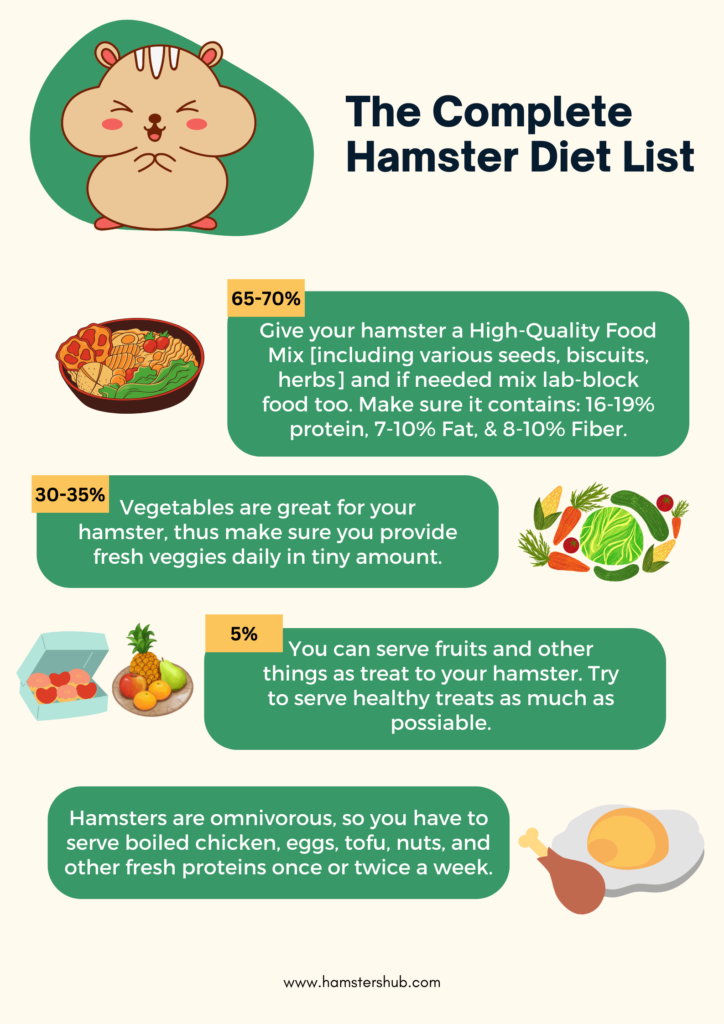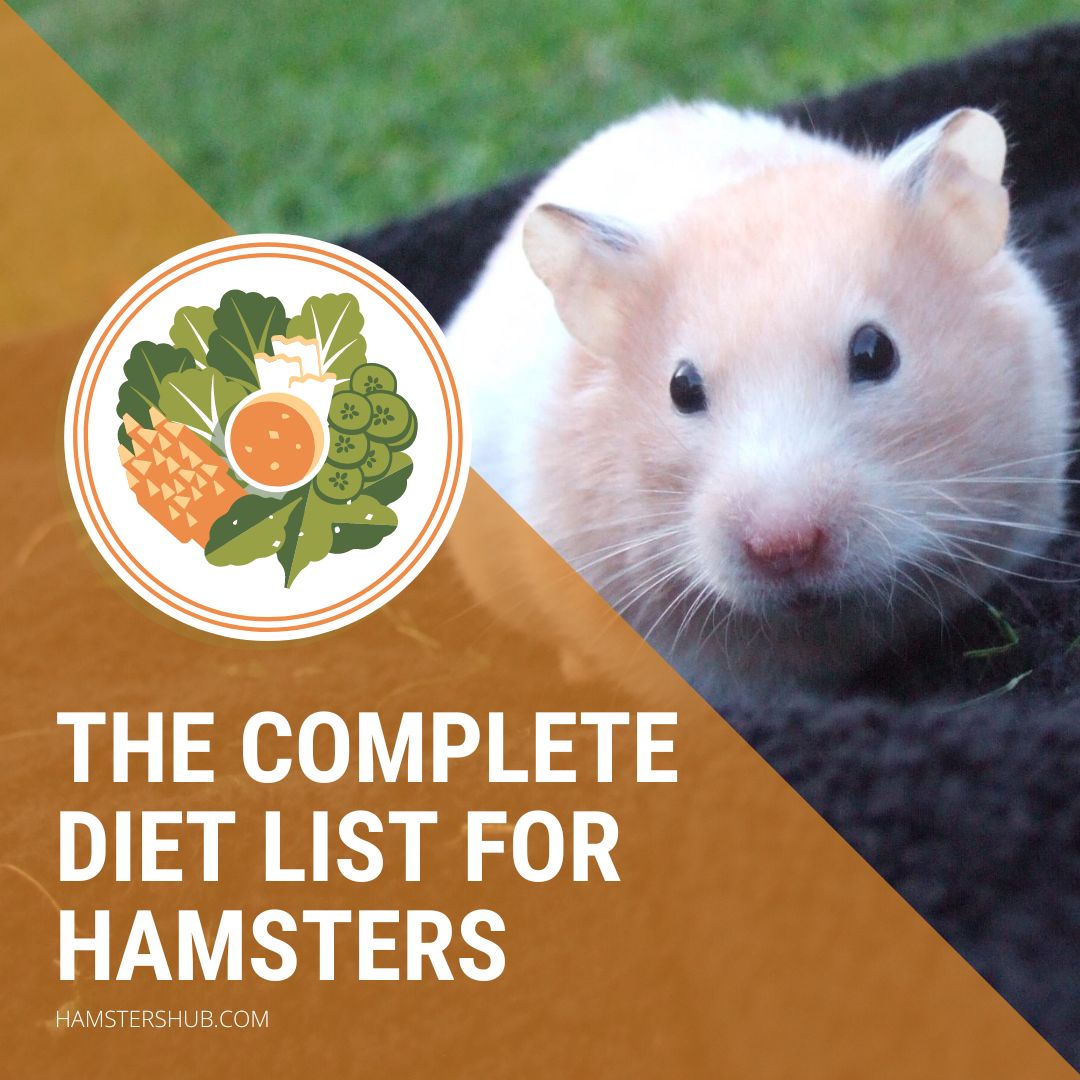Food is essential for living, whether hamsters, humans, or other creatures. Not only living but food also helps to maintain our health.
For all the new hamster owners, it is important to know what to feed your hamsters and the right amount of food to keep them healthy.
Keeping them healthy will make them live longer and have fun with you.
So I discussed with a few hamster specialists and a few other hamster owners about the perfect daily diet for hamsters, and here are their suggestions.
How Many Times in a Day Do Hamsters Eat & How Much?
Before starting to feed your hamster, it is essential to know how many times a day a hamster eats & the amount unless you’ll end up feeding too much or less.
That will cause stomach pain, diarrhea, malnutrition, and other health problems.
A hamster can eat food multiple times a day, although they don’t eat a lot. So, you have to ensure the food is available for them not all the time, but once they finish, you can serve the next food. You can serve them 1-2 tbsp of food mix every other day, and they’ll eat several times from that serving. With their staple food, you can serve vegetables daily.
Also, the amount of food depends on many things, like the species of the hamster, age, and others. A Syrian hamster can eat 1 to 2 tbsp a day, while a dwarf hamster can eat 1-2 tbsp in 3 days.
Similarly, Robo hamsters are often marked as slow eaters.
So the best answer is to check how fast your hamster finishes the food you’re serving, and then you can serve food accordingly. If your hamster finishes the food daily, you have to serve the food every day.
And if it is a slow eater, then serving food once after 2-3 days is fine. Thus, observing your hamster is key to serving food at the right time and at the right amount.
What Do Hamsters Eat in the Wild?
If you want to take proper care of your hamster and serve them the foods they need to fulfill their daily nutrient requirements, then you must know what they eat in the wild.
Knowing their eating habits in the wild will help you to make a correct and high-nutritious diet for your hamster. Because in my study, I’ve found that many hamster owners don’t feed correctly to their hamsters, and there is wrong information on the internet and the market.
Hamsters are omnivores, and in the wild, they eat grasses, grains, seeds, leaves of plants, flowers, fruits, nuts, veggies, herbs, small incests [crickets], and other things. So there is a balance of different nutrients like vitamins, minerals, fats, proteins, and more. And this also proves they love varieties.
Also, as they eat most of their foods raw, they get most of the nutrients. So you can also try most of the things raw. And often, you can cook and serve a few foods to your hamsters because of the taste burden.
Dietary Requirements for Hamsters
Having clear-cut information about your hamster’s dietary requirements can help you choose the best food for your hamsters. So here is a detailed guide you can note.
The dietary requirements of hamsters vary from young hamsters to older ones, so here’s the list;
| Stages of Hamsters | Protein | Fat | Fiber |
|---|---|---|---|
| Baby Hamsters [3-6 months] | 18%-19% | 7%-10% | 8%-10% |
| Adult Hamsters [6 months -1 year] | 16%-18% | 7%-10% | 10%-12% |
| Older Hamsters [1-1.5 years] | 15%-17% | 7% | 10%-12% |
| Elderly Hamsters [1.5-2.5 years] | 15%-16% | 5%-7% | 12% |
| Last Stages [2.5 years+] | 13%-15% | 5% | 12%-15% |
***Also, ensure you don’t exceed 23% of the protein limit; for elder hamsters, 15% is the right percentage, as elder hamsters are prone to kidney disease.
Pro Tip: While feeding anything to your hamster, make sure it is rich in vitamins, minerals, protein, and others. But remember, don’t feed your hamster high-fat, carbohydrate foods. According to a study by Salley and Bryson, they have decreased the mortality rate of hamsters by lowering sugar or carbohydrate consumption. Instead, they served cornstarch or cellulose.[1]National Library of Medicine
The Perfect & Balanced Daily Diet for Hamsters
Many new hamster owners mostly serve commercial pelleted diets or the cheapest seed mix, but that is not enough for them as hamsters don’t get all the required nutrients, especially protein, from the pelleted diet. Sadly, many websites have written so much wrong info; therefore, often, newbies make mistakes.
So whenever you choose your hamster’s main diet, you must ensure it contains the dietary nutrients mentioned earlier or ensure their food should have 16% to 19% proteins, 4%-7% fat, and 6%-15% fibre. Commercial Pellets don’t have that much protein; therefore, they are low-quality food for them.
Also, the pelleted diet doesn’t have a lot of varieties that a hamster needs. Just think, in the wild, they eat different things or various foods, not just a single food, as they have great tastes. And also they don’t live long so, serving a variety of foods is a great idea.
Moreover, many owners only serve one type of food, but that is incorrect; you should care about the main diet, vegetables, fruits, proteins, treats, and often supplements.
So what is the best food or daily diet for hamsters?
- 65%-70% Food Mix, including various seeds, biscuits, and herbs
- 30%-35% Vegetables
- Only 5% of healthy treats like Fruits and other things.
- Once or Twice a week, serve extra protein from chicken, eggs, and others.

Here I’ve discussed the complete diet, time, servings, and more! Let’s check.
#The Staple Food or Daily Diet [65%-70%]
So a good seeds mix can be a great staple food or daily diet for your hamster. But, there are a lot of food mixes for hamsters that are low quality and don’t provide enough proteins. So, according to a few hamster owners, only providing seeds mix is not enough because here is a fact,
If you’re from the US, most of the hamsters’ seed mix doesn’t meet the 18% protein requirement, whereas most of the seed mix is enough and provides 18% protein in the UK and Europe. So the hamsters’ food differs from country to country. Thus, it’s your responsibility to check before buying.
So, a high-quality food mix [including various seeds, herbs & biscuits] with lab-block food is a great staple food for your hamsters, as it provides all the required nutrients they need as well as serves a great variety to hamsters, which they like. Although, people from UK/Europe mostly don’t provide lab-block food, as their seed mixes are enough. 65% to 70% of their daily diet should be a great food mix.
Hence, if your hamster’s diet doesn’t fulfill the required nutrients, this can be the best staple diet for your hamster.
Many people like to make their homemade food mix for hamsters to make it as nutritious as possible. As we all know, finding the right food mix can be difficult for your hamsters.
Also, if you only want to serve food mixes, you can order the mixes from the UK or Europe through online stores that deliver in the USA.
Note: Accroding to the European pets laws, the companies don’t have to list all the ingredients in their food items. For instance, they can list only “cerels” instead of specificying all the grains. Thus, it can be difficult to analyze the food, therefore here is a list for you.
#Vegetables [30%-35%]
Vegetables are truly important for hamsters. Many hamster owners may be scared to feed their hamsters vegetables regularly due to stomach upset and diarrhea, which is true, but most hamster owners serve vegetables incorrectly.
But vegetables are important to feed your hamsters, as they get a lot of nutrients from vegetables that their main diet might be unable to provide. Therefore you should be feeding vegetables to your hamster on a regular basis. 30%-35% of your hamster’s daily diet should be vegetables.
If you correctly serve your hamster vegetables, then there’ll be no problem, and it is really important to serve vegetables to your hamster besides their staple diet. Here are a few points you can follow;
- If your hamster is just starting with veggies, then slowly introduce them. Don’t feed a variety of vegetables at once. Let them habituate, then serving various vegetables is the best idea.
- Don’t feed your hamster too much vegetables. The serving amount should be low. Cut tiny pieces of different veggies and serve.
- Fresh veggies without any chemicals.
If you want to know more about what vegetables are best for them, how to feed vegetables to your hamsters [cooked or raw], and more, then I’ve got this post for you; check now.
#Treats & Snacks [5%]
You can also provide various things like different fruits, nuts, and some snacks item as treats to your hamsters. While serving treats, try to provide your hamster with healthy items instead of junk foods.
Treats that are not that healthy try to feed those items to your hamsters in moderation. Fruits are great for hamsters, which I’ve discussed here;
#Fruits
Just like vegetables, fruits are also important for hamsters and provide many extra nutrients. Thus, as a hamster owner, you can serve different fruits to your hamster 2-3 times a week. You can get apples, blueberries, or other fruits and serve them in tiny amounts as a treat.
But always remember to introduce fruits slowly as well, and then you can serve a variety of fruits to your hamsters. Another important thing is, don’t serve citrus fruits to your hamsters like oranges, grapefruit, and others.
Due to the high acidic content of citrus fruits, your hamsters might have stomach problems. So here I’ve listed a few safe & unsafe fruits you can serve to your hamster as treats; check now.
#Proteins & Non-Veg
Hamsters are omnivorous; in the wild, they eat plant-based foods and incests. So it is important to remember to feed non-veg foods to your hamster, or they can have serious health problems like malnutrition and others.
You can feed your hamster non-veg items like boiled chicken & eggs, raw tofu, nuts, and other items. Often you can serve them Mealworms to your hammy. You can serve a few boiled chicken, egg pieces, tofu, and nuts.
Lab blocks are great for proteins that most hamster owners include with seed mix.
Once or twice a week or more, you can serve these varieties of fresh proteins to your hamsters. Or if you’re serving daily, then only serve a few pieces of chicken and the next day a few pieces of eggs, and continue the circle.
These fresh raw proteins will help your hamster boost its immunity and growth, repair cells, build bones and muscle, and much more.
Again, don’t cross the max protein limit of 23% for adult hamsters; for elder hamsters, 15% is the protein limit.
#Supplements
Many Hamster owners mix a few drops of vitamin and mineral supplements for extra growth and nutrients. But you always don’t need this; if you think your hamster needs this or your VET advice to mix it in their foods, you can do so.
Note: Choosing the Hamsters’ foods might be critical at beginning, and also remember the diet varies from hamsters to hamsters. So observe your hamster and check what is suiting the best and make the diet plan accrodingly.
What is the Best Way to Serve Food To a Hamster?
There are a couple of ways hamsters owners feed their hamsters. But, unknowingly, many of them feed incorrectly to their hamster.
Mostly, hamster owners serve food in a dish or bowl, which is absolutely fine. But think about how they eat foods in the wild; they search here and there, collect food in their pouches, and eat them. So often, you can sprinkle their food in the enclosure.
And don’t worry; your hamster has a pretty good smell gland, and they will find the food from the hardest places.
Secondly, don’t serve food until they finish the previous serving, because if you do so, they will know they don’t have to put in a lot of effort, and the food will always be available; thus, they’ll become a picky eater.
A picky eater might not eat everything, only the things they love, and in that way, they might not get enough nutrients and suffer from various health issues.
Diet Difference between Syrian & Dwarf Hamsters
There is not much main diet difference between Syrian and dwarf species. The main difference is that Syrian hamsters are big in size, so they can eat more food, whereas dwarf hamsters are not known for eating a lot.
Hence, Syrian hamsters can finish their food within a day or 2; but Dwarf hamsters can take up to 2-3 days to finish all their food.
Robo hamsters are also in the dwarf category, so they are also in the slow eaters. However, this can vary from hamster to hamster depending on various things.
But, generally, this is the main diet difference. The other difference might be dwarf hamsters should not eat too much surgery food as they are the main candidates for diabetes among other species.
Few Types of Foods to Avoid for Hamsters’ Well-being
Sugary Foods: Hamsters are prone to diabetes; although mostly dwarf hamsters have diabetes, with excessive sugary foods, any species can have diabetes.
Salty Foods: Salty food items can cause dehydration and other health issues to your hamsters.
Sticky Foods: Hamsters have the habit of saving food on their pouches, so if you feed them sticky food items, they can stick in their pouches and cause serious health issues.
Acidic Foods: As mentioned earlier, acidic items can cause stomach upset in your hamsters.
High-Fat Foods: Foods with high fat should not be fed excessively to your hamsters, as it can cause obesity and cause various health issues.
References
| ↑1 | National Library of Medicine |
|---|

